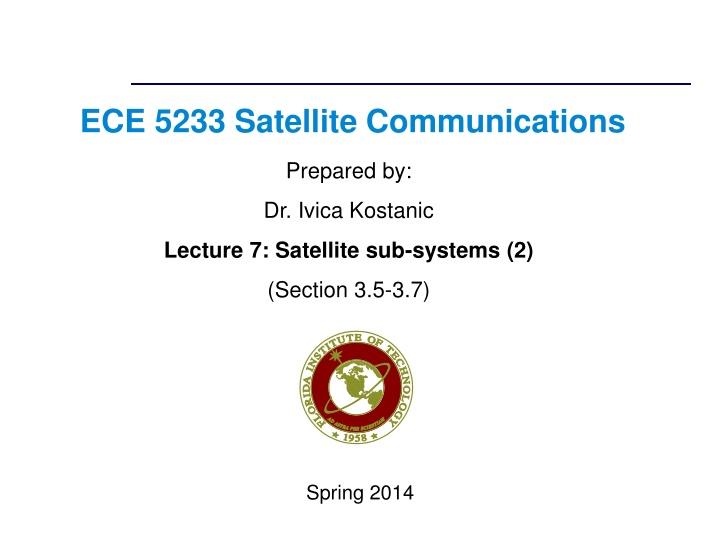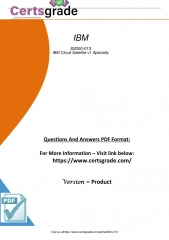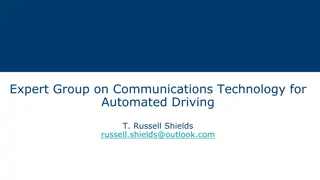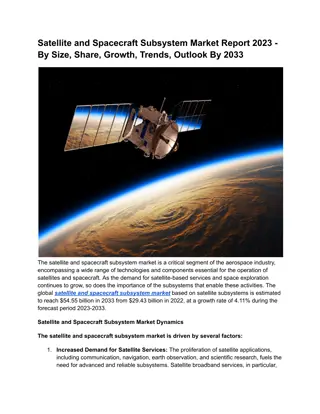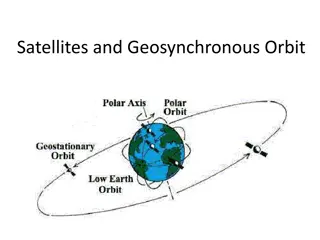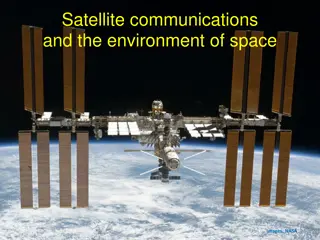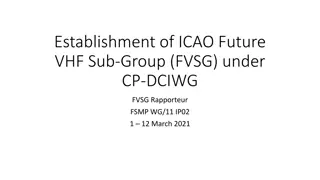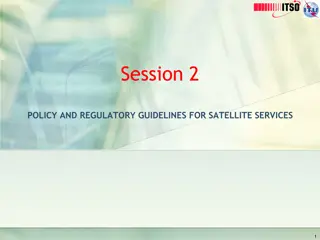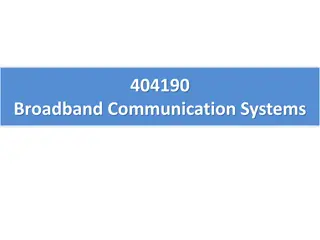Overview of Satellite Communication Sub-systems in ECE 5233: Satellite Communications
This content provides insights into satellite communication sub-systems such as transponders, antenna systems, and frequency plans. It covers topics like double conversion transponders, regenerative transponders, and examples of frequency allocation in satellite transponders. The detailed block diagrams and explanations offer a comprehensive understanding of the satellite communication domain.
Download Presentation

Please find below an Image/Link to download the presentation.
The content on the website is provided AS IS for your information and personal use only. It may not be sold, licensed, or shared on other websites without obtaining consent from the author.If you encounter any issues during the download, it is possible that the publisher has removed the file from their server.
You are allowed to download the files provided on this website for personal or commercial use, subject to the condition that they are used lawfully. All files are the property of their respective owners.
The content on the website is provided AS IS for your information and personal use only. It may not be sold, licensed, or shared on other websites without obtaining consent from the author.
E N D
Presentation Transcript
ECE 5233 Satellite Communications Prepared by: Dr. Ivica Kostanic Lecture 7: Satellite sub-systems (2) (Section 3.5-3.7) Spring 2014
Outline Block diagrams of transponders Satellite antenna systems Examples Important note: Slides present summary of the results. Detailed derivations are given in notes. Page 2 Florida Institute of technologies
Simplified double conversion transponder Easier to make cost and power efficient filters at lower frequencies Two step conversion: o From RX frequency to lower IF o From lower IF to TX frequency Signal processing and amplification done at IF Two step conversion architecture common for Ku band (14/11 GHz band) Drawback 2PAs o HPAs are least reliable components o Usually substantial redundancy is built typically M:N = 2:1 (i.e. one spare HPA for every active one Strict emission requirements highly selective filters Outline of double conversion transponder architecture Filters frequently followed by phase equalization circuits extremely important for digital communication transponders Page 3 Florida Institute of technologies
Regenerative transponders On board processing Transponder switch in the sky Usually deployed along with multi-beam antennas o Beams are narrow high gain o Point to point communication provides link budget advantages o Capacity of the link is increased better spectrum utilization Used in Ka band where antenna arrays are smaller (high operating frequency) Switched beams, high-gain antennas increase re-use of the spectrum Design of the satellite more complicated due to all of the processing requirements On board processing increases latency Simplified block diagram of a regenerative transponder Page 4 Florida Institute of technologies
Satellite transponders example of frequency plan Total of 500MHz of spectrum available Each transponder occupies 40MHz (36MHz for signal and 4MHz for guard band) Frequency is reused through orthogonal polarization allows separation of 20MHz between two transponder channels Due to orthogonal polarization based frequency reuse 24 transponders in 500MHz bandwidth Each transponder is allocated a pair of frequency allocations o Example: Transponder 3 works on horizontal polarization, transmits in the range 3740- 3780MHz and receives 5965-6005MHz Transponder is single manageable capacity unit of a satellite Example of C-band frequency plan for IT region 2 (Americas) Domestically price for a transponder capacity is about 1.5M$-2M$/year Page 5 Florida Institute of technologies
Antennas Used for TX and RX of EM waves Example of a satellite antenna Characterized by the o Antenna gain o Antenna pattern o Beamwidth o Efficiency o Impedance In satellite communication antenna is critical o Light weight o High gain (narrow beam) o High efficiency o Polarization purity Antenna pattern parameters Satellite usually has 2 antenna systems o Communication o TTC&M Elements of a satellite Note: 2 antennas Page 6 Florida Institute of technologies
Types of satellite antennas Wire antennas (UHF & VHF) Antenna coverage may be o TTC&M o Global beam cover as much as possible (17 degrees of beamwidth from GEO) o Mobile users on the ground Horn + reflector antennas (dishes) o Spot beams cover smaller area on the ground o Antenna arrays Multiple switched beams o Feeds for reflectors (high gain) Phase array beams Multiple feeds + reflector (phased arrays) Orthogonally polarized beams o Used to generate multiple beams o Used for pattern shaping AMC-6 coverage example of global coverage ViaSat (WildBlue) example of spot beam global coverage Page 7 Florida Institute of technologies
Basic relationships Approximate relationships used for nominal planning and feasibility studies Gain of an antenna 3dB beamwidth of the antenna in degrees 4 = 75 / D G A 3 D dimension of the antenna in the beamwidth plane dB A 2 A antenna aperture in m^2 wavelength in m Relationship between beamwidth and gain A aperture efficiency (0.55-0.8) 4 . 5 55 10 G For circular antenna with diameter D A 2 3 dB 2 D = G A Note: all antenna gains are linear Page 8 Florida Institute of technologies
Examples Continental US subtends angle of approximately 6 by 3 degrees when viewed from the geostationary orbit. What dimensions must reflector antenna have to illuminate half of the area with circular beam of 3 degrees at 11GHz? What would be dimensions of the reflector that illuminates the whole area? What is a gain of such antenna (assume 60% efficiency)? The Earth is viewed at the angle of 17 degrees form geo stationary orbit. What are dimensions of a horn antenna that provides global coverage at 4GHz? What would be a gain of that antenna? D/ = 4.4 Answer: at 4GHz, D = 0.33m Answer 1 : D = 0.68m Gain: 20dB in the main beam Answer 2: D1 = 0.68m, D2 = 034m Answer 3: g = 32.6dB Page 9 Florida Institute of technologies
Some practical considerations Antennas often limiting elements o High gain requirements o Low beamwidth requirements o High efficiency requirements o Position an tracking requirements o Beam shaping requirements irregular beam shapes Size of the antenna is inversely proportional to the frequency (i.e. directly proportional to the wavelength) o As the frequency becomes higher smaller and more advanced antennas become possible Ka band antenna array (Harris, Melbourne, FL) Page 10 Florida Institute of technologies
